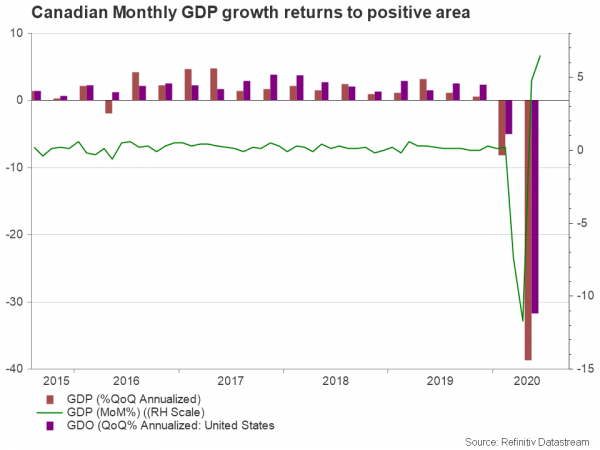Canadian employment readings will be closely watched on Friday at 12:30 GMT as markets weigh the prospects of Canada recovering faster than the US in the coming quarters. Forecasts suggest a decline in the jobless rate and a softer rise in employment, which could endorse the growing optimism, especially if the numbers come in brighter-than-expected, further fuelling the rally in the loonie.
Canada’s fortunes could be better than US’s
The loonie scored five consecutive green months against the US dollar but August brought the bulk of gains, adding 2.8% to its value mainly because of the US political uncertainty. Although President Donald Trump temporarily extended unemployment benefits, the Congress recessed in August with divisions over a second fiscal stimulus package remaining wide open between Republicans and Democrats at a time when the EU and other key economies have their financial plans already settled.
The Canadian prime minister Justin Trudeau is also facing pressure over his leadership this month amid a charity scandal that forced him to prorogue the Parliament and call for a confidence vote in the government on September 23 after Murneau’s resignation as a Minister of Finance. Yet, Trudeau managed to immediately appoint the deputy PM Chrystia Freeland in the position and extend CERB payments for another four weeks, while also making the employment insurance program (EI) more accessible to unemployed people who are actively seeking employment. Moreover, after his throne speech on September 23, which will provide an update on how the country will move forward with the pandemic measures, the opposition parties could trigger an election if they vote against his leadership, though unlike the US, political risks are currently minimal as the polls suggest that Trudeau could be re-elected.
Besides, although Canadian infection cases have registered some spikes recently, the numbers do not look like a second wave of Covid-19 yet, giving some relief to Trudeau and increasing optimism that an economic rebound in the third quarter could be faster in Canada than in the US as the reopening measures came into effect in Canada as well and fiscal stimulus kicked in.
The second quarter was historically one of the worst for Canada and was uglier than the one in the US , with GDP plunging by an annualized rate of 38.7%. Household consumption and housing investment were down by half and the plunge in exports was not good news for commodity-dependent Canada. However, monthly GDP readings for June arrived stronger-than-expected, showing a growth of 6.5% and suggesting that the economy might have entered the third quarter on the right foot. The six largest banks in Canada estimate on average that the economy could rebound by 36% annualized in Q3 versus the 20% expansion in the US because of a greater success in controlling the virus spread.
Unemployment rate to keep declining
Friday’s employment readings could endorse that view if the unemployment rate ticks down for a third consecutive month, from 10.9% to 10.1% in August. New employment is expected to increase at a softer pace of 275k versus 418k seen in the preceding month, but this could be considered as a return to pre-pandemic normal levels after the extraordinary spike in June. A more furious rise could signal that even more people are returning to work. So, in either case, the employment change may not have a negative impact on the loonie as long as the unemployment rate keeps falling.
Negative risks are still in place
However, it could be too early to hope for a relatively stronger Canada in the future given its close borders with the US and the fact that 75% of its exports are landing in the biggest economy of the world. Hence, any economic deterioration in the States could easily spill over into Canada. Policymakers are certainly aware of that fact, and they must also grapple with how to further stimulate the economy if health conditions worsen and an effective vaccine is not confirmed by the end of the year. The central bank has already driven interest rates to a record low of 0.25% and has no intention to push them below zero, especially if other countries avoid doing so. Regarding quantitative easing, asset purchases have been exploding over the past few months, reaching almost 30% of GDP, hence there is not much left to do when the Bank of Canada’s next policy meeting takes place on September 9.
Speaking at the Jackson Hole Symposium in Wyoming, the BoC chief explained the importance of engaging with the public about how the central bank’s actions serve economic objectives after releasing its “Let’s talk inflation” survey to gather opinions. Hence, discussions could turn around price targeting in the year ahead following the Fed’s decision to relax its inflation goal and the plunge in CPI measures. Note that the households saving rate, which is negatively correlated with inflation, has been steadily increasing in uncharted territory over the past few months.
Nevertheless, the bank could take the back seat for now and let the government act first at the end of the month.
USD/CAD levels to watch
Looking at the data impact, the famous US Non-farm payrolls (NFP) report is coming out at the same time on Friday. Hence, the loonie’s reaction could be a matter of which of those reports will suprise better. If the NFP disappoints, an encouraging employment report out of Canada could benefit the loonie, pushing USD/CAD towards the 1.3040-1.2860 support region. Slightly lower, the 1.2880 barrier will be closely watched in case of steeper declines.
Alternatively, if the NFP numbers beat expectations, it would be interestig to see if the pair can pierce the descending channel and the broken long-term ascending trendline at 1.3200 and run towards the 1.3300 mark.
